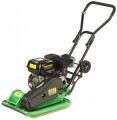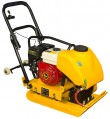Impact force
The force of each impact provided by the vibrating plate during operation. The intensity of the impact directly depends on this indicator, and, consequently, the density and thickness of the material that the vibrating plate can effectively compact. At the same time, in some cases (for example, when working with paving slabs), a high impact force may be undesirable. Recommendations on the optimal value of this indicator for different cases can be found in special sources.
Vibration frequency
The frequency of movements made by the sole of the tool in normal operation. For different materials, the optimal vibration frequency may also be different; specific recommendations can be found in special sources. It should be noted that classical vibrating plates (see "Type") have a rather high frequency of operation — from 3700 beats / min and above, but in vibrating rammers this figure is much lower and rarely exceeds 700 beats / min; such differences are due to differences in the way they work.
Sole length
The length of the sole — the working surface of the sole. The sole area depends on the length and width (see below) — that is, the space captured by the vibrating plate without moving from its place. Larger soles are comfortable for large volumes of work in wide spaces, while more compact ones perform better in tight spaces and apply more pressure (all other things being equal).
Sole width
The width of the working surface of the vibrating plate. The area of the sole depends on the length and width, respectively, its suitability for processing large spaces. Specifically, the width determines, on the one hand, the size of the strip captured in one pass, on the other hand, the passability of the unit. So, for open spaces, wide soles will be convenient, they will allow you to cope with the processing in fewer passes; but when working in narrow places, the width should be small, otherwise the vibrating plate may simply not fit in the right place.
Speed
The speed of the vibrating plate in normal operation. This parameter, along with the size of the sole, determines the performance of the unit. High speed allows you to quickly cope with a vast amount of work, however, it requires the appropriate engine power, which affects the "gluttony" and the price of the vibrating plate.
Engine size
The working volume of the internal combustion engine installed in the vibrating plate. The power of the unit and fuel consumption directly depend on this indicator. At the same time, manufacturers usually choose the volume in such a way as to provide the necessary power; therefore, this parameter in fact is secondary, and when choosing, it makes sense to focus more on power, and not on volume.
Power
Vibratory plate motor power in horsepower. Horsepower is traditionally used to denote the power of internal combustion engines (see "Engine"); 1 HP approximately equal to 735 watts.
Higher power, other things being equal, makes the tool easier to work with and reduces the effort required to control it. On the other hand, this indicator significantly affects the cost and consumption of electricity or fuel (depending on the type of engine, see above). Also note that the vibrating plate motor must be powerful enough to, firstly, move it forward, and secondly, provide the desired vibration frequency and not allow it to “burrow” into the material being processed. At the same time, in inexpensive models, the cost is sometimes reduced precisely through the use of low-power engines. Therefore, if the power seems too small for such a weight, it is better to clarify this ratio (there are special tables for this) and, if necessary, refrain from buying.
Power
Vibratory plate motor power in kilowatts. Watt (kilowatt) is the universal unit of power; unlike horsepower, this designation is used for all types of engines.
Higher power, other things being equal, makes the tool easier to work with and reduces the effort required to control it. On the other hand, this indicator significantly affects the cost and consumption of electricity or fuel (depending on the type of engine, see above). Also note that the vibrating plate motor must be powerful enough to, firstly, move it forward, and secondly, provide the desired vibration frequency and not allow it to “burrow” into the material being processed. At the same time, in inexpensive models, the cost is sometimes reduced precisely through the use of low-power engines. Therefore, if the power seems too small for such a weight, it is better to clarify this ratio (there are special tables for this) and, if necessary, refrain from buying.
Water sprinkler system
The presence
of an irrigation system in the design of the vibrating plate.
Some types of work (in particular, with asphalt and bituminous mixtures) require constant wetting of the sole of the vibrating plate so that the rammed material does not stick to it. For such cases, irrigation systems are provided, consisting of a water tank and a system for supplying it to the sole.

